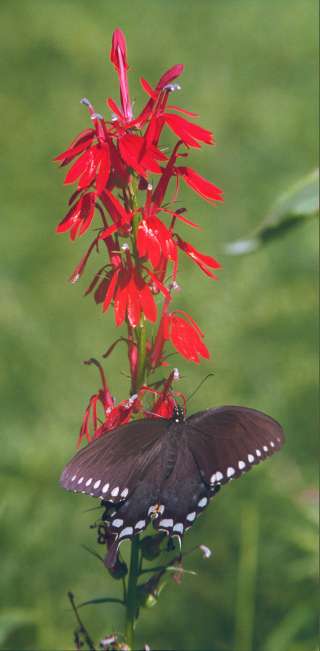

PHOTO COURTESY OF GARRY KESSLER
Cardinal flowers along the shores of Sandra Pond attract a spicebush swallowtail butterfly (Papilio troilus). Red is great color for catching the attention of hummingbirds and butterflies.
July 22, 2005, Page 11
NATURE NOTES
By ANNIE REID
Westborough Community Land Trust
Cardinal flower attracts hummingbirds, butterflies
A prime hummingbird and butterfly flower and perhaps our most beautiful native wildflower, the brilliant red cardinal flower is getting ready to bloom at the water's edge of Westborough's ponds and streams.
Named for the red robes of Roman Catholic cardinals, cardinal flower (Lobelia cardinalis) is a well-kept secret of the woods because of the way it hugs the shorelines. Its showy, intense red blossoms are a treat for people who fish from shore or travel Westborough's waters by canoe or other boats. The tall plants grow in partial shade in the wet ground at the edges of ponds, streams, and sometimes even swamps.
European explorers were impressed by this beautiful wetlands flower when they first found it growing in Canada in the 1620s, but sadly, its numbers have been declining ever since. As people have filled or drained North America's wetlands, first for agriculture and then for development, the cardinal flower's habitat has been disappearing. And so, too, has the cardinal flower, although it is not yet endangered in most states.
Cardinal flower blooms from July to September, but the best time to view it in Westborough is usually the last week of July or the first week or so in August. Follow paths along the shorelines at Sandra Pond (the Westborough Reservoir) or Mill Pond and look in partly shady spots. As water use lowers the water level at Sandra Pond, you may be able to walk along the newly exposed shores. The Bowman Conservation Area side of the pond is usually a good place to look. A few plants usually bloom on the shore near the foot bridge to the small island there.
The eye-catching red flowers attract wildlife, especially hummingbirds and butterflies, which drink the nectar. Hummingbirds pollinate the flowers in the process. Other birds such as goldfinches feast on the small seeds. The spikes of flowers open from the bottom up, so a plant can have seeds at the bottom of a spike at the same time that it has fresh blossoms at the top—a banquet for all.
The scarlet blossoms are especially well-suited for hummingbirds, which are their chief pollinators. In our area, ruby-throated hummingbirds (Archilochus colubrus) visit cardinal flowers. These tiny green birds (with red throats if they're males) hover and poke their long bills deep into the tube-like flowers to reach the nectar at the back. Pollen gets deposited on the hummingbird's head and is transferred to other flowers that the bird visits.
Cardinal flower is a short-lived perennial. It spreads both by seed and by shoots, which take two years to grow into mature flowering plants. Sizeable colonies of plants can develop in favorable locations.
The plant is also sometimes called red lobelia to distinguish it from related lobelias with blue flowers.
Cardinal flower has had limited medicinal uses in the past. Native Americans used a root tea to treat stomach problems, worms, typhoid, and syphilis. They made a leaf tea for colds, fevers, headaches, and rheumatism. Like other lobelias, which had wider use as medicines, it contains a chemical called lobeline. This active ingredient is also somewhat toxic.
Some Native Americans also used cardinal flower in love potions or as an antidote to witchcraft. It also had ceremonial uses in rain dances and in warding off storms.
Nature Notes update: This summer's warm, wet weather has made it a good season so far for ghostly white Indian-pipes (Monotropa uniflora), which have been coming up in the woods. This year has also been better than last year for common St. Johnswort (Hypericum perforatum). The last of its yellow flowers can still be seen along roads and trails. And painted turtles (Chrysemys picta) are around again. Watch for them basking on logs in ponds or crossing roads and trails. Be careful not to run them over!